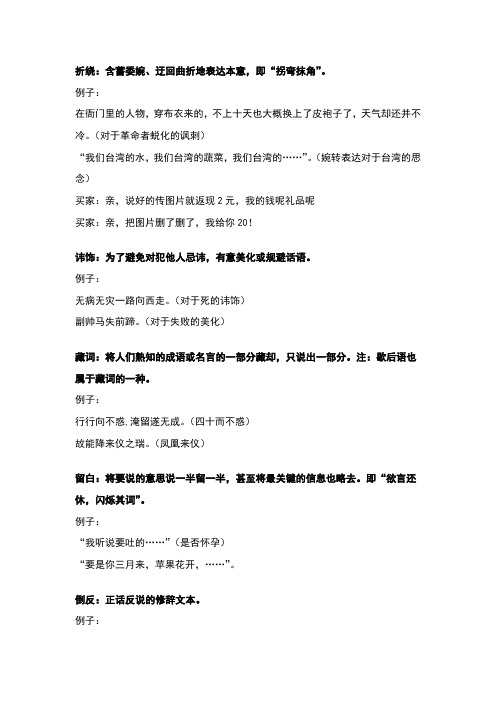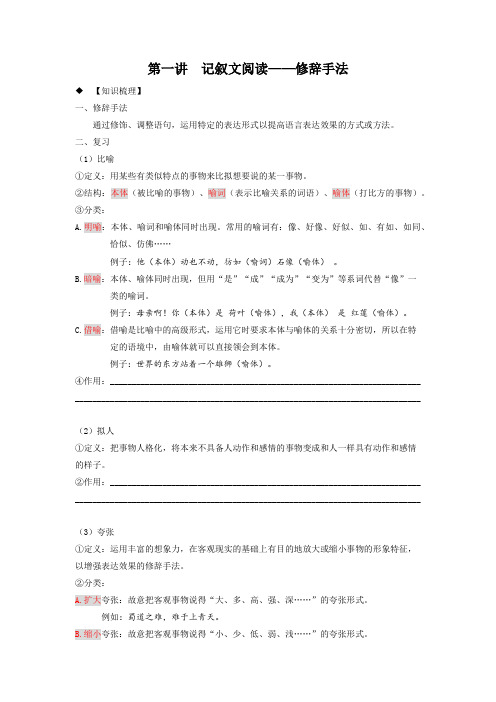修辞学 (1)
修辞学 权威版

1、修辞、修辞学(1)修辞就是言语交际参与者在特定的语言环境下,根据表达内容的需要,运用相应的语言形式,恰切地建构话语和解构、理解话语,以达到理想交际效果的活动。
是努力提高语言表达和接受效果的活动。
(2)修辞学是研究提高表达和接受效果的规律的科学,就是研究言语交际表达主体如何依据和利用语境选择语言材料和修辞手段,组建能够适切表达思想内容的话语,以及接受主体如何正确理解和接受表达主体所传话语信息的规律、规则的学科。
2、修辞和修辞学的本质属性?(1)修辞是言语现象。
是运用语言增强交际效果的活动,任何修辞活动都要依据具体的言语环境去运用语言表达手段恰切组建话语和透过语言表达手段正确理解话语,才能达到预期的交际目的和效果。
修辞主要依据动态语境。
随动态语境选用语言表达手段组成的话语是语言运用的产物。
人们运用语言,不管在口语还是书面语的表达和接受,都会有修辞上的考虑和要求。
修辞寓于语言的具体运用之中,人们运用语言总是离不开修辞。
(2)修辞学属于语言运用科学或者说言语科学范畴,是一门既有系统性理论,又有很强实用性的科学。
修辞学的研究对象是修辞现象,修辞现象是人们运用语言进行交际的产物,它的本质特性属于语言运用的范畴。
修辞学以普通语言学尤其是语用学理论作为指导思想,。
语言学对修辞学体系的建立和探索分析至关重要。
3、修辞和修辞学的社会价值(1)修辞是兴国立业的重要手段。
如外交辞。
(2)修辞是提高自我修养、文明礼貌的重要手段。
善于运用修辞规律,有利达成交际目的和塑造自身的美好形象。
一个人在言语交际中选用什么样的修辞手段和表现手法组建话语,显示出什么样的语言风貌、格调和能否正确理解话语,都体现出一个人的思想境界、精神风貌和形象。
(3)修辞是商品社会中创造经济价值的重要手段。
(4)修辞学在社会科学中具有重要的地位和作用。
文学艺术、美学、哲学等。
修辞的意义:1、帮助我们说的话更加动听,文章写得更优美2、帮助我们欣赏别人的语辞3、对一篇作品,不但可以知其然美,而且还可以知其所以然(为什么美,美在何处)4、帮助我们分析作者的措辞、造句技巧、认识语辞、文辞美在何处的知识。
现代汉语修辞学 吴礼权

折绕:含蓄委婉、迂回曲折地表达本意,即“拐弯抹角”。
例子:在衙门里的人物,穿布衣来的,不上十天也大概换上了皮袍子了,天气却还并不冷。
(对于革命者蜕化的讽刺)“我们台湾的水,我们台湾的蔬菜,我们台湾的……”。
(婉转表达对于台湾的思念)买家:亲,说好的传图片就返现2元,我的钱呢礼品呢买家:亲,把图片删了删了,我给你20!讳饰:为了避免对犯他人忌讳,有意美化或规避话语。
例子:无病无灾一路向西走。
(对于死的讳饰)副帅马失前蹄。
(对于失败的美化)藏词:将人们熟知的成语或名言的一部分藏却,只说出一部分。
注:歇后语也属于藏词的一种。
例子:行行向不惑,淹留遂无成。
(四十而不惑)故能降来仪之瑞。
(凤凰来仪)留白:将要说的意思说一半留一半,甚至将最关键的信息也略去。
即“欲言还休,闪烁其词”。
例子:“我听说要吐的……”(是否怀孕)“要是你三月来,苹果花开,……”。
倒反:正话反说的修辞文本。
例子:中国是世界上最提倡科学的国家。
没有国家肯这样给科学家大官做的。
(反讽)“你的高见,实在不敢沟通。
”推避:表意明确,而又故作掩饰,即“心是口非”。
(文本后一部分常用“不知道”之类的话推辞,或用“总所周知”、“不言自明”之类的辞令来回避)例子:他的社会主义怎么样呢,我不知道。
有多少效果呢,我不知道。
由于大家都知道的原因,两国人民之间的往来中断了二十多年。
讽喻:于特定语境中临时编造一个故事来讽刺或教导,即“讲故事”。
摹状:描摹事物情状以致形象逼真的修辞手法,即“栩栩如生”。
例子:“关关雎鸠,在河之洲”。
眉间深深地印着“川”字,额头上深深地印着“三”字纹。
列锦:将名词或以名次为中心的短语进行铺排,组成多项排列的特殊非主谓句,即“名词铺排”。
例子:春雨-古宅-念珠。
枯藤老树昏鸦,小桥流水人家。
四十年来家园,三千里地江山。
飞白:飞白又名“非别”,是一种明知说错或写错,而故意如实援用或仿效的修辞手法。
即“将错就错”。
例子:赵:听你妈说你搁哪研究爹呢?范:(笑)不是,没有,研究木乃伊。
(完整版)修辞学模拟试题及答案

汉语修辞学模拟试题(一)一、填空题(每空1分,共20分)1、修辞与逻辑从提高语言表达效果看,两者既有()的一面,又有()的一面。
2、同义的语言形式是指一些基本()相仿而在()上各有差别的语言形式。
3、语言里的专用词可以分为两大类,即()词汇和()词汇。
4、应该选择什么样的句式,跟文章的()、文体风格和句子的()有密切关系。
5、修辞既然是一门研究()的方法和技巧的学科,就必然应以()为主要研究对象。
6、同义词用法上的差别,主要表现在()、构词能力和()上。
7、在汉语里,时态助词、表示时态的语气词、()和()都可以表示跟时间相关的概念。
8、长句的特点是()、()和容量大。
9、汉语的句式从结构的角度,可以分成独词句、()、()等句式。
10、比喻的运用原则是:第一要();第二要()。
二、综合分析题(每题5分,共30分)1、分析下列句子中辞格运用的情况及表达效果。
(1)、“一九七六年,十月初的一个夜晚,已经有了秋凉萧条的意思。
蟋蟀在一个角隅悲伤地啼哭!”。
(2)、“玉秀一看到他那装腔作势的酸溜溜的样子,就感到恶心。
”(徐迟:《地质之光》)2、将下列句子调整句式(1)、战士们把敌人的碉堡炸毁了。
(改成被动句)(2)、“度过了讨饭的童年生活,在财东马房里睡觉的少年,青年时代又在秦岭荒山里混日子,他不知道世界上有什么可以叫做“困难”。
”(改成整句)3、指出下列句子加点词语使用的特点和表达效果。
(1)、“黑云堆成了一整片,象一块黑铁,渐渐地往地面上沉:似乎已经盖到了屋脊上,再过一会儿就得把屋子压扁。
”(2)、“它是一种腐蚀剂,使团结涣散,关系松懈,工作消散,意见分歧。
”三、简答题(每题10分,共30分)1、传统的修辞方式包括哪两大类?2、构成警策性语句的方式常见的有哪三类?3、简述什么是短句和长句及其各自的特点。
四、论述题(20分)试结合实例谈谈你是如何理解修辞和语言要素的关系的。
汉语修辞学模拟试题(二)一、填空题(每空1分,共20分)1、语言就是人类最重要的交际工具,每种语言都有它自身的内部规律,即它的语音、()、()的系统和规则。
汉语修辞学模拟试题1

汉语修辞学模拟试题1一、填空题(20分,每空1分)1、“辞达”与“言文”的结合是修辞学说的重要内容。
他的论述在中国修辞学史上具有开创性。
2、南朝刘勰的是我国丰富的文学创作经验的理论总结,对修辞也有精深的阐述。
4、我们要学好修辞,一定要学好、、等有关知识,这样才有牢固的基础。
5、人们如果巧妙地利用的某种特殊条件进行修辞活动,就能使人语言焕发出夺目的光彩。
6、词语锤炼与运用的基本方法有:、、7、成语具有意义的和结构的的特点。
8、串对又称上下联意义相承,表示连贯、递进、因果、条件等关系。
9、现代汉语中平声指、,仄声指、10、比喻从结构上说包括、、三个部分。
二、选择题(每题2分,共20分)1、我国最早把“修”和“辞”连用(“修辞立其诚”)的著作是A.《论语》B.《孟子》C.《易经》D.《老子》2、我国历史上第一部专门论述修辞的著作是A.《文心雕龙》B.《文则》C.《文选》D.《文赋》3、我国最早提出“修辞格”这一名称的学者是A.孔子B.刘勰C.唐钺D.陈望道4、“一头猪等于一个有机化工厂。
”属于比喻中的A.明喻B.借喻C.暗喻(喻体—本体)D.暗喻(本体—喻体)5、“刚才仿佛有人探了一下头似的”属于A.明喻B.暗喻C.表比较D.表不确定6、“每条岭都是那样温柔”属于比拟中的A.无生命事物拟人化B.有生命事物拟人化 C.把人拟作物D.把一物拟作另一物7、“乡下来了保姆,他不用再做马大嫂了”属于A.语义双关B.谐音双关C.对象双关D.判断8、“烟锁池塘柳、炮镇海城楼”属于A.正对、严对B.正对、宽对C.反对、严对D.反对、宽对9、“空山新雨后”起头的这首诗属于近体诗中的A.平起平收B.平起仄收C.仄起平收D.仄起仄收10、“窈窕、坎坷、姐姐、太太”这些词语分别属于A.双声、叠韵、词的重叠、叠音词B.叠韵、双声、词的重叠、叠音词C.双声、叠韵、叠音词、词的重叠D.双声、词的重叠、叠韵、叠音词三、分析题(共20分,每题5分)1、从语音角度分析下面一段话的修辞效果。
(完整版)修辞学[1]
![(完整版)修辞学[1]](https://img.taocdn.com/s3/m/5973829fcc7931b765ce159d.png)
一语法实体及其分类语法实体,是一种语言中构成语法系统的实际要素。
分为语素、词、短语、复句、句群、句子语气。
语素:最小的音义结合体。
主要作用是构词。
(花儿为两个语素)词:能独立运用的最小语法单位。
分为单纯词、合成词。
词的独立运用分为以下三种情况:1.能单独回答问题,即单说。
(实词)2.能单独充当句子成分。
(实词)3.将能单说的部分踢开,将能单独与充当句子成分的踢开,剩下的总分也是词。
(虚词)短语:由两个或两个以上的词,按照一定的语法规则和语义规则组合起来的,没有特定语调的语法单位。
小句:即句子。
指最小的,能独立表达一个意思的,有一定的证据语调的语法单位。
(一般语素不加语气构成句子,而以词+语气构成句子。
)复句:包含两个或两个以上的分句组成,分句在意义上密切相关,在结构上互不包含。
句群:指包含两个或两个以上句子的语法单位。
句子语气:指句子所带有的某种语气,属超音质成分。
语法实体——是一种语言中构成语法系统的实际要素。
专家语法系统——与教学语法系统相比,专家语法系统往往鲜明地反映专家的个人特点。
语法实体分类:单位语法实体—语素、词、短语、小句、复句、句群非单位语法实体—句子语气基础语法实体—语素、词、短语、句子语气—静太实体。
—其中:词、短语—构件语法单位;句子语气—致句语法单位表述语法实体—小句、复句、句群—动态实体可切分语法实体—短语、小句、复句、句群不可切分语法实体—语素、词、句子语气二汉语语法及其系统语法,指语言中语素、词、短语的结构规则。
汉语语法,指汉语各类各级语法褓的构成规则和组合规则的总和。
构成—从大往小;组合—从小到大汉语语法系统的两个定义:1.汉语语法本身的系统,即客户存在的语法系统。
2.汉语语法学系统,即对客观语法系统的主观研究和描写。
语法学:是研究语法的科学。
汉语语法学的发展历程如下:套用期马建忠(马相伯)—《马氏文通》—文言文研究—1898年黎锦熙—《新著国语文法》—白话文研究—1924年王力—〈〈中国现代语法〉〉—1943年引发期吕叔湘—〈〈中国方法要略〉〉—1942~1944年高名凯—〈〈汉语语法论〉〉—1945年丁声树—〈〈现代汉语语法讲话〉〉—1961年探求期吕叔湘—〈〈汉语语法分析问题〉〉—1979年朱德熙—〈〈语法讲义〉〉—1982年三汉语教学语法系统教学语法系统,指从语法教学实际出发,根据中学评议教学的需要,强调规范性,注重实践性,尽量避免有争议的观点和问题,以传统语法和现代应用为基础而建立起来的语法系统。
修辞学[1]
![修辞学[1]](https://img.taocdn.com/s3/m/4f56eed576eeaeaad1f330b4.png)
一语法实体及其分类语法实体,是一种语言中构成语法系统的实际要素。
分为语素、词、短语、复句、句群、句子语气。
语素:最小的音义结合体。
主要作用是构词。
(花儿为两个语素)词:能独立运用的最小语法单位。
分为单纯词、合成词。
词的独立运用分为以下三种情况:1.能单独回答问题,即单说。
(实词)2.能单独充当句子成分。
(实词)3.将能单说的部分踢开,将能单独与充当句子成分的踢开,剩下的总分也是词。
(虚词)短语:由两个或两个以上的词,按照一定的语法规则和语义规则组合起来的,没有特定语调的语法单位。
小句:即句子。
指最小的,能独立表达一个意思的,有一定的证据语调的语法单位。
(一般语素不加语气构成句子,而以词+语气构成句子。
)复句:包含两个或两个以上的分句组成,分句在意义上密切相关,在结构上互不包含。
句群:指包含两个或两个以上句子的语法单位。
句子语气:指句子所带有的某种语气,属超音质成分。
语法实体——是一种语言中构成语法系统的实际要素。
专家语法系统——与教学语法系统相比,专家语法系统往往鲜明地反映专家的个人特点。
语法实体分类:单位语法实体—语素、词、短语、小句、复句、句群非单位语法实体—句子语气基础语法实体—语素、词、短语、句子语气—静太实体。
—其中:词、短语—构件语法单位;句子语气—致句语法单位表述语法实体—小句、复句、句群—动态实体可切分语法实体—短语、小句、复句、句群不可切分语法实体—语素、词、句子语气二汉语语法及其系统语法,指语言中语素、词、短语的结构规则。
汉语语法,指汉语各类各级语法褓的构成规则和组合规则的总和。
构成—从大往小;组合—从小到大汉语语法系统的两个定义:1.汉语语法本身的系统,即客户存在的语法系统。
2.汉语语法学系统,即对客观语法系统的主观研究和描写。
语法学:是研究语法的科学。
汉语语法学的发展历程如下:套用期马建忠(马相伯)—《马氏文通》—文言文研究—1898年黎锦熙—《新著国语文法》—白话文研究—1924年王力—〈〈中国现代语法〉〉—1943年引发期吕叔湘—〈〈中国方法要略〉〉—1942~1944年高名凯—〈〈汉语语法论〉〉—1945年丁声树—〈〈现代汉语语法讲话〉〉—1961年探求期吕叔湘—〈〈汉语语法分析问题〉〉—1979年朱德熙—〈〈语法讲义〉〉—1982年三汉语教学语法系统教学语法系统,指从语法教学实际出发,根据中学评议教学的需要,强调规范性,注重实践性,尽量避免有争议的观点和问题,以传统语法和现代应用为基础而建立起来的语法系统。
Rhetoric 1 明喻暗喻拟人

体,规范,明确。
• 狭义(积极修辞):只包括各种修辞格 (figure of speech) 的运用,并通过这种运用修辞格的手法使语言发生变异,
以实现较为强烈的交际效果。要求达到形象生动。
• 概言之,修辞学就是选择、修饰语言以保证或提高交际效 果或语言运用效果的艺术。
语法与修辞的关系
狭义修辞:对语法的偏离
• 因为缺钱,而且想做点有意义的事,我申请了那 份工作,但我没有学历,没有教书经验,恐怕得 到这份工作希望渺茫。 • Being very short of money and wanting to do something useful, I applied, fearing as I did so, that without a degree and with no experience of teaching my chances of landing the job were slim.
• It (the hair) stands straight up like the wool on a sheep. It is black as night and around the edges are two long pigtails that rope about like small lizards disappearing behind her ears.
比喻中的三种成分
• • • • • 本体(tenor):需要描画的事物 喻体(vehicle ):用作比喻的事物如 比喻词(indicator),如like, as 明喻中三个成分都出现。 My love is like a red red rose.
• 英汉基本相同:把所要描写的事物与另一具有鲜明特性的 事物通过比喻词连接起来,从而更形象更生动地说明事物 的特征。 • 英语常用的比喻词除了like, as 以外,还有seem, as if, as though, such as 等 • 例如: • Last night Bob slept like a log.
修辞1

(二)整句和散句 • 单独的句子无所谓整句和散句之分。整 句和散句是一组相对的概念。 • 整句:结构相同或相似的一组句子。 • 散句:结构不整齐,各式各样的句子交 错运用的一组句子。例如:
整句形式整齐,声音和谐,气势贯通, 意义鲜明。在散文、诗歌、唱词中应用较 广,适合于表达丰富的感情,能给人以深 刻、鲜明的印象。例如: 走生路,生而出新;走险路,险而出奇; 走难路,难而不俗。 (徐刚《黄山拾美》) 三部分句子字数、结构都相同,构成排 比格式。形式齐整匀称,表意简练醒目。
(四)词语的音节要匀称 音节匀称主要是指结构相似、音节数目 相等。 一句话的音节整齐匀称就可以形成节奏, 节奏是汉语语音美的一个重要内容。 先看一个反例:
春天,不仅带来希冀、新生、美、向上 的力、大自然的繁忙、五彩缤纷的新天地, 还要与亲切真诚的吐露、劳动者手上的厚 茧、描绘未来的图纸、为了真理而斗争的 硝烟、柔情的眼波、迷人的夜曲,编织成 甜蜜、幸福、闪闪发光的生活。 (冯骥才《啊!》) 这一段文字描写,有人用“杂乱不和谐” 来评价它 ,也就是缺少音节节奏的考虑。
②在那山径上,碧水边,姑娘们飘着彩色 长裙,顶着竹篮、水罐,走回开满波斯菊的 家园。 (魏巍《依依惜别的深情》) 这一句则是“飘”字显出了生动。它写出 了轻盈的步态,仿佛姑娘们裙下生风,正轻 快地走来。试想,如果不是用“飘”,而是 用“穿”,还有动感美感吗?
(三)词语的活用 有时出于表达上的需要,要对某些 词语“变通”使用,有意改变其词性和 功能,这就是词语活用。 词语活用可以使得言语表达生动形 象,达到一种意想不到的独特效果。例 如:
同游的一位编修顺口说道:“有犬卧通 衢,逸马蹄而死之。”另一位编修说:“有 马逸於街衢,卧犬遭之而毙。”欧阳修听了 却不以为然地说:“您二位这样写太罗嗦了。 要用此法去编写历史,恐怕写万卷还写不完 呢。”二位编修反问欧阳修:“那么照你的 写法呢?”欧阳修说只用“逸马杀犬于通” 六个字就可以了。二人听了都十分赞赏。
修辞学作业1

(封面)修辞研究考查作业学院:学号:班级:姓名:第一章婉约蕴藉的修辞文本营构模式1.然而曾几何时,知命之年,倏尔而逝;耳顺之年,也没有留下什么痕迹,连古稀之年也没能让我有古稀的感觉。
(季羡林《过年的感觉》)答:修辞模式:用典修辞效果:以用典的修辞文本模式来表情达意,在表达上可以表达者的达意传情显得婉约含蓄。
2。
小孩子上山就得采花;到海边就得拾贝壳,书呆子进图书馆想捞新智慧—出门人到了巴黎就想……(徐志摩《巴黎鳞爪》)答:修辞模式:藏词修辞效果:情意展露半遮半掩,表达婉约蕴藉。
3.相传有人爱写字,尤其是爱写扇子,后来腿坏,以至无扇可写;人问其故,原来是大家见了他就跑,他追赶不上了。
如果字果真写到好处,当然不需要腿健,但写字的人究竟是腿健者居多。
(梁实秋《写字》)答:修辞模式:讽喻修辞效果:表达有含蓄婉约深文隐蔚的效果魅力比较深厚。
4.……跟女友共一把雨伞,该是一种美丽的合作吧。
最好是初恋,有点兴奋,更有点不好意思,若即若离之间,雨不妨下大一点。
真正初恋,恐怕是兴奋得不需要伞的,手牵手在雨中狂奔而去,把年轻的长发和肌肤交给漫天的淋淋漓漓,然后向对方的唇上颊上尝凉凉甜甜的雨水,不过那要非常年轻且激情,同时也只能发生在法国的新湘片里吧。
(余光中《听听那冷雨》)答:修辞模式:折绕修辞效果:表达上有一种婉约深沉,余味曲包的妙趣。
5.四十岁了,没有多余的情感和时间可以挥霍,且专致地爱脚跟下的这片土地吧!且虔诚地维护头顶的那片青天吧!生平不识一张牌,却生就了大赌徒的性格,押下去的那份筹码,其数值自己也不知道,只知道是余生的岁岁年年,赌的是什么?是在我垂睫大去之际能看到较澄澈的河流,较清鲜的空气……(张晓风《情怀》)答:修辞模式:双关修辞效果:表达上显得内涵丰富而又婉约蕴藉,别有一种秘响旁通的独特效果。
6.谚云:“树大自直”,意思是说孩子不需管教,小时悠肆些,大了自然会好。
可是弯曲的小树,长大是否会直呢?我不敢说。
第二节 语言表达的十八般武艺——修辞手法(1)

——比喻与比拟
比喻
比喻:是用本质不同而又有相似点的事 物描绘事物或说明道理的辞格,是修辞 学上的辞格之一。即以甲事物来比拟乙 事物。
如:她的脸像红苹果。
比喻的类别
它在形式上,具有本体、喻体和比喻 词三个成分。因这三个成分的异同和 隐现,比喻可分为明喻、隐喻(暗喻) 和借喻三类。
注意事项
诗句中只出现甲事物,乙事物不出现。
比拟重在拟,即“当作”它直接把甲当作乙来 描述。
高考题展示
2016年山东卷 阅读下面的元曲,回答问题。(8分)
水仙子•舟中 孙周卿
孤舟夜泊洞庭边,灯火青荧对客船。 朔风吹老梅花片,推开篷雪满天。 诗豪 与风雪争先,雪片与风鏖战,诗和雪缴缠。 一笑琅然。
分析“诗豪与风雪争先,雪片与风鏖战,诗 和雪缴缠”使用的两种修辞手法。(4分)
2反应事物的关系不同:比喻是甲喻乙,两者有相似点,是相似关 系。比拟是甲拟乙,两者融为一体,两者是相融关系。
3表达效果不同:比喻重在喻,用浅近形象的事物说明深奥抽象的 事物。比拟重在用模拟的方法描绘物或人的行为状态。
比如:“感时花溅泪,恨别鸟惊心 “ 杜甫《春望》(比拟) 大漠沙如雪,燕山月似钩 李贺《马诗二十三首》(其五) (比喻)
诗歌鉴赏修辞答题步骤
通过上面的高考真题讲解,一是强化了对于 “比喻”和“比拟“修辞的理解,同时也熟悉 了这种体型的答题步骤。
第一步,指出所用的修辞手法。 第二步,结合诗句具体分析。 第三步,点明表达效果。
比喻与比拟的区别:
1形式不同:比喻可出现“本体、连接词和喻体”或“连接词和喻 体”,比拟只出现“被模仿的拟体”
高考题展示
2016全国Ⅱ卷阅读下面这首唐诗,完成8、9题。
修辞手法练习题(一)

11.下列语句中,没有使用比喻手法的一项是( )
A.“一带一路”是我国为推动经济全球化而提出的一项互利共赢的倡议,它已成为推动全球经济转型升级、走出衰退困境的新引擎。
B.气象部门预计,随着暖湿气流增强,我省明天会迎来一场及时雨,空气中污染物浓度将快速下降,人们的舒适度会大幅度提升。
25.下列各句中,没有使用比喻手法的一项是( )
A.人生的开始总是在摇篮中,摇篮就是一条船,它的首次航行目标必定是那座神秘的桥,慈祥的外婆就住在桥边。
B.天蓝得可爱,仿佛一汪水似的,月儿便更出落得精神了,岸上有三株两株的垂杨树,淡淡的影子在水里摇曳着。
C.雅舍地势较高,得月较先,看山头吐月,红盘乍涌,一霎间,清光四射,天空皎洁,四野无声、微闻犬吠,坐客无不悄然!
B.美国包着纸的橘子遇到北平带霜儿的玉李,还不愧杀!
C.你到了悬崖的边缘,前面是寂静的深谷,不,连深谷也不是。
D.我要用手指那涌向天边的排浪,我要用手掌那托住太阳的大海,摇曳着曙光那支温暖漂亮的笔杆,用孩子的笔体写下:相信未来。
3.下列句子修辞手法运用不恰当的一项是( )
A.欢笑盛开在眉毛、眼睛上,心啊,要从嘴里跳出。
C.一种突如其来的网络病毒洪水猛兽般地袭击全球,导致150多个国家受灾,我国也有近3万家机构的计算机受到影响。
D.我国企业在参与发展中国家的基础设施建设过程中,主动强化环保意识,积极承担社会责任,带动了东道主在观念上弯道超车。
12.下列诗句中,没有使14.下列诗句与所用手法对应的一项是( )
古诗词中常因为修辞之妙而给读者留下深刻印象。如“________”运用了借代的手法;“________”运用了比喻的手法;“________”运用了比拟的手法;“________”运用了夸张的手法。
第1讲 记叙文阅读1——修辞手法 -2024-2025学年七年级语文上册专题复习讲义(统编版)

第一讲记叙文阅读——修辞手法【知识梳理】一、修辞手法通过修饰、调整语句,运用特定的表达形式以提高语言表达效果的方式或方法。
二、复习(1)比喻①定义:用某些有类似特点的事物来比拟想要说的某一事物。
②结构:本体(被比喻的事物)、喻词(表示比喻关系的词语)、喻体(打比方的事物)。
③分类:A.明喻:本体、喻词和喻体同时出现。
常用的喻词有:像、好像、好似、如、有如、如同、恰似、仿佛……例子:他(本体)动也不动,彷如(喻词)石像(喻体)。
B.暗喻:本体、喻体同时出现,但用“是”“成”“成为”“变为”等系词代替“像”一类的喻词。
例子:母亲啊!你(本体)是荷叶(喻体),我(本体)是红莲(喻体)。
C.借喻:借喻是比喻中的高级形式,运用它时要求本体与喻体的关系十分密切,所以在特定的语境中,由喻体就可以直接领会到本体。
例子:世界的东方站着一个雄狮(喻体)。
④作用:_______________________________________________________________________ _______________________________________________________________________________(2)拟人①定义:把事物人格化,将本来不具备人动作和感情的事物变成和人一样具有动作和感情的样子。
②作用:_______________________________________________________________________ _______________________________________________________________________________(3)夸张①定义:运用丰富的想象力,在客观现实的基础上有目的地放大或缩小事物的形象特征,以增强表达效果的修辞手法。
②分类:A.扩大夸张:故意把客观事物说得“大、多、高、强、深……”的夸张形式。
修辞手法(1)

呼告
呼告又称“顿呼”、“突呼”,就是在说话 或写文章的过程中,叙述某人或某物时,由 于感情过于激动,突然撇开听众或者读者, 而直接和所涉及的人或物说话的一种修辞格。
例1:硕鼠!硕鼠! 无食我黍。 《诗经· 硕鼠》 例2:天啊!为什么你要这样对我? 例3:你,你东君,你是什么个东君?别人 说你是太阳神,你,你坐在那马上丝毫也不 能驰骋。
语言表达运用专题复习
——修辞手法
自从高考不把修辞手法独立作为考点 以来,我们对修辞的学习就没有加以足 够的重视,甚至在高考复习时把它排除 在外,认为这不是重点,复习它是浪费 时间。其实这是一个误区。且不说修辞 手法的使用对写作的作用(这是人所尽 知的),单从语言表达与阅读鉴赏上看, 修辞用法的理解与运用都是非常需要的, 至少以下几类题目需要利用修辞知识。
(2012山东卷) 16. 根据语境,仿照下面的句子中本体(画 线部分)的句式,补写出两个恰当的喻体。 (4分) 作诗填词,本来是为了传情达意。如果写出 的诗词不能传情达意,这就有如 , 又如 , 还有什么用呢? 【答案】示例一:做出的饭不能吃 缝好 的衣服不能穿 示例二:盖的房子无法居住 修建的高速 路不能通车
借代与借喻的区别: 一、两者构成基础不同: 借代构成基础——相关性 借喻构成基础——相似性 1、我们之闻已经隔了一层可悲的厚障壁了。 2、不拿群众的一针一线。 二、两者作用不同: 借代的作用——代 借喻的作用——喻(可以改成明喻)
1、要克服困难,必须开动机器。 2、红领巾唱着歌儿迎面走来。
1、忽如一夜春风来,千树万树梨花开。 借喻 2、初发的龙头翻卷滚动,在凹凸不平的沟 床上缓慢前进。借喻 借代 3、先生给现洋钱,袁世凯,不行吗? 借代 4、江山如此多娇,引无数英雄竞折腰。 5、我们应当禁绝一切空话。但是主要的和 首先的任务,是把那些又长又臭的懒婆娘的 裹脚,赶快扔到垃圾桶里去。 借喻 6、红眼睛原知道他家里只有一个老娘,可 是没有料到他竟会那么穷,榨不出一点油水 已经气破肚皮了。 借代
英语修辞学(Rhetoric).ppt

4. 英语被动句用得多,汉语主动句用得多。这更说明了英语 的“物称倾向”。 An illustration is furnished by an editorial in the Washington Post (January 17, 1962). 《华盛顿邮报》(1962年1月17日)的一篇社论提供了一个 例子。 It has been known for a long time that there is a first relationship between the heart and liver. 长期以来,大家知道心脏和肝脏的关系是最重要的。 The challenge from the Third World has always been foreseen by our shipping companies. 我国的海运公司总能预见来自第三世界的挑战。
Illustrative说明型
Illuminative启发型
E.g.
What happened to a dream deferred 延期的 (postponed)? Like a raisin (葡萄干) in the sun? Or fester (化脓) like a sore? Does it stink like a rotten meat?
英语修辞学(Rhetoric)
English Figures of Speech
英语修辞的一般规律与特点 General principles and features of English rhetoric
1. 关系词丰富,介词、连词、关系代词和关系副词 等的充分利用,使英语成为一种更为形式的语言, 即以形合为主的语言。而汉语是以意合为主的语言。
修辞学-应用语言学的一个分支

修辞学-应用语言学的一个分支口?修辞学习2oo0年弟2期(总目8期修辞学J9口修辞学在语言学和应用语言学这个大学科的归属问题.从目前的研究成果来看,倾向于语言学的一个分支.张弓先生明确指出:.修辞学是语言学的一个部门.张志公先生也提出:修辞学是语言科学的一个分支.王希杰先生在9O年代再次强调:修辞学的属便是语言学."他们一般认为修辞学以语言系统的语音,词忙语法三个方面的规律为基础并且是语言三要素的实际运用.总之漫有脱离语言符系统. 处于语言符号的运用范围之内.于是新兴的语用学则成为修辞学的现代语育学理论的一块基石.有的学者还认为修辞学与语用学是异曲同工,殊连同归. 语用学属于语言学的研究范围,从它的产生和发展趋势都是如此.看来,修辞学的归宿是在语言学的大圈子里.似乎无可置疑.当然.有些修辞学者也认为修辞学并非纯语言学科有人想把它立为艺术学科,建立修辞艺术学. 张志公先生曾经讲过修辞是运用语言的艺术,但是艺术地运用语胄仅是修辞的一个方面而不是它的垒部内容;有人想把它放进美学领域,谭永祥先生有力作<汉语修辞美学)问世,但是追求语言运用的美感,也是修辞学所涉及的一部分问题.倘若修辞学属于艺术学或美学的一个分支,那幺没有艺术价值,没有美学价值,也就毫无修辞可言了,于是乎陈望道先生确立的修辞两大分野——消极修辞与积极修辞的理论就被否定了,消极修辞成了.皇帝的新表,于是乎法律条文,学术论文等自然没有什幺修辞问题可供论及了.看来,修辞学划归艺术学或美学的通路,尚存障碍物.这里还有一个不大好逾越的逻辑障碍,比如文学创作也有艺术价值和美学价值,以至把具有高度的艺术价值和美学价值的称之为艺术品.但这并不能说文学就属于艺术学或美学学科.因为文学与艺术学或美学是不同质的,文学的特质在于它是以语言为工具,对于社会生活进行审美的形象的反映,这就使其不同于其它的艺术形态,而取得了独立性,文学与艺术并肩而立.同样修辞学也不能因为需要研究语言运用的艺术或美学价值,就由此列人了艺术或美学学科.修辞学确乎和艺术学,美学有着密切联系t它与文学,语言学的关系更是异乎寻常,所以在 8O年代张志公先生曾经有过.修辞学是门边缘学科的看法.但是,世纪之交学科发展的渗透性和交叉性非常广泛,如果由于这种已经常见的现象,就把某些具有相对独立胜的学科视为边缘学科.将不利于这一类学科的建设和发展.在修辞学被视为边缘学科时.正如张志公先生所指出的那样:研兜语言学的人认为它不是纯语言的东西,研究文艺学的人认为它不是纯文艺的东西,因而不被重视,研究的步, 比较薄弱.如果说修辞学不属于艺术学,美学或纯语言学学科,那幺划人应用语盲学学科,有什幺充足的理由吗?这个问题要从德?索绪尔在(普通语盲学教程) 里区分语言和言语谈起.索绪尔认为语言"是一种表达观念的符号系统,.是一种杜会制度,是社会集团为了使个人有可能行使这机能所采用的一整套必不可少的规约."但是,这个系统不是封闭的,这种制度不是凝固的.这套规约也不是板滞的,因为"语吉既是言语的工具,又是肓语的产物.促使语言演变的是言语.言语,在索培尔看来,.是个人的意志和智能的行为,是.说话者赖以运用语言规则表达他的个人思想的组舍.诚然,索绪尔把言语视为永远是由个人进行的,.个人永远是它的主人,这是不全面的.索绪尔对于语言和言语的区分.给了修辞学研究者一个重要启示.那就是修辞学不以语言学的既定范围为对象,具体说来不是以存在于全民杜会中并被普遍公认的语音,词于[,语法的静态系统为对象,而是以个体写说者所构造的句子为基点,以组合而成的表情达意的言语作品为对象.并且修辞所追求的还不是一般的言语表达,乃是充满了个人创造性的颇具良好效果的盲语方面的达意传情.当;{!}由个人写说所形成的言语作品,绝非纯属个人现象,因为言语作品(包括日常谈话)必然要进人社会交际场舍,说的要让大家听懂听好.写的要让大家看懂看好,它就必须在社会一致公认的语言符号系统之中择其适用的,它也必须遵循社会约定俗成的语体的得体性和语境的切境性.而这些正好说明了盲语现象也是一种杜会现象,并非佳誊缝髓的臻样个人——1——永远是它的主人"永远二字l天妥.因为经过修辞活动的写说成品,在个^是它的l丰^的程度上,远远超过了一般的育语作品.它还常常做语言系缆中语音,词汇语法三要素的已由垒社会所形成的规约的叛离昔.达也确乎是事实.周振市先生在《中同修辞学史》中援弓f的钱钟书先生的阐述就是刈证:文法求文从字顺,而修辞则每反常规,姣律乖度,重言嗣叠而不以为烦,倒装逆插不以为戾,所谓.不通.之'通'……,又按捷克形式主义论师谓'诗歌语言'必有突出处.不瞄乖违习蹦'标准语言"之文法词律,划意破常示异故科以'标准语盲'之惯规,'诗歌语言'每不通不顺.这里所言的"'不通.之'通?和.不通不顺是对于具有修辞价值的言语特征的最简要的概括.道明了修辞不可能以语法的惯搜为基础,倒是有一种修辞先行的现象值得研讨.比如:北京当前出现了清洁城市的大型标语,这可不是语法上所说的偏正结构.即非清洁的城市之意.达大标语中的"清洁是动作性的意义.城市是清洁动作的对象.但是从语法埙规而言,.清洁只能充当形容词,不是动词,不能带宾语.这是修辞的一种创新性的应f1i, 即所谓活用诃性.目前,清洁办公室,清洁教室,清洁房屋,清洁宿舍等述设有推广开来.一旦推广开来, 语法学家就会总结m清洁具有了形容词和动词的兼类用法,那时清洁的动词用法就进入了语亩系统.仅此而言t修辞现象不是以语法理论为基础.不属于语言内部系统,倒是语法惯规的一个资源. 这是否可以说明修群不懈于语言学内部惯规" 系统的研究范围,它是切台具体语言环境的各种因素,在各娄功能语俸当中,诸如文学,科技,政论,法规,广播电视等(这些叉是同各种社会意识形志,从学术角度即各种一二级学科,如自然科学,法律学, 政治学,文学,艺术学等联系在一起)的语言应用.刘涌泉先生等编着《应用语育学》一书指出,广义的解释应用语言学,它是语言学知识在各个领域中不同应用的薛称.它研究语言如何得到最佳利用的问题.".这在中国修辞学发展历史的过程中,也_口』以找到依据.修辞学史家认为刘勰的《文心雕龙》是中国占代修群学初步建立的着述,但其中讲的语言学知的应坩.是在文学创作和文学;论领域的应认为陈联的《文则》是巾固占代修辞学完全确立的里程似所论及的语肓学知识的应刷,也硅碑式的专着,文章学{包括文学史学,哲学各英文章1领域的;芷 J.可见修辞学从代起就不是语言系统部的语音词,语法自身规约或者以这_二要索为基础的语言惯规使用的静志描写,它是论述语青学知识其它学科领域,在中周古代主要是文学和文章学之巾的效果突出的动恋应Hj,在现代则包括r一切写 c兑的领域.因此修辞不于语言的第田个要素,不宜列入纯语言学研究的一十分支,把宦放到广义的应刚语言学之巾倒是更合适一些.在此有必要重温高名凯先生早在60年代的一段论述:"以往的修辞学事实上就是言语语弃学的研究,它所研究的正是如何运用语育中的词成分和语法成分去有效和巧妙地组织言语作品的JuJ题,不是对语言中的词汇系统和语涪系统的单纯的研究就是现代语言学巾所兴起的所谓实用语育学,例如统计语言学,机器翻译学,电子通讯半等,也是研究 ^们对语言的实际运用,也是研究』,们之如何组织言语作品或如何翻译不同的语言成分所组成的言语作品的,换言之.也是在注意语言之如何被运用,人们之如何组织言语作品的问题中而必起的.现代语言风格学的必起并且是言语理论的直接产物.语青在特殊的交际场合,为适应某一特殊的交际日的的情况下而分化成的各种风格手段系统,正是代语言风格学所要研究的对象.高名凯先生在此所说的实川语育学即今天的应用语言学.他还强调也是注意语言之如何被运J, 人们之如何组织言语作品的问题中而必起的.其中这也是一语,笔者理解,有把修辞学和现代语青风格学别^实用语言学(即应用语育学)分支的考虑. 所以,将修辞学定位于应用语言学的范围内,比起归属语言学有着更多的旨理性,比起_删为边缘学科更有利于它的发展前景和建立独立的科学卵论体系.(上楼第3页)名遐迩,"久仰大名,威名递扬,.威震天下,.有口皆碑,'名不虚传.恭维人的才学:"雄才大略, "文武双全,学贯中西,.盖世英雄",出类拔萃, 学富五车,远见卓识.恭维人的道德:"高风亮 _节,操尚弥高,"守正不剐太公无私,声誉卓着.恭维人的功绩:劳苦功高,"丰功伟绩","汗马 2功劳,德无量,.勋劳卓着.恭维^的独创精神:独树一帆,"匠心独运,独辟蹊径,"别H一格.总之,我们要在新世纪振礼仪,就必须面考察借鉴中华文化典籍中有生命力的语料,进一步弘扬民族精神,表现叶1华民族传统美德,并嗳取外束文化中有用成份,来构建具有中国特色的文化礼仪。
实用的汉语修辞练习(1)

2008春季汉语言文学本科《汉语修辞学》形成性作业学校名称学生姓名学生学号班级2009年11月 1 《汉语修辞学》平时作业1 一、填空1、我国修辞学的研究源远流长早在古人就已经注意到了修辞现象提出了自己的见解。
先秦两汉2、“修…和”辞“的连用最早见于”君子进德修业。
忠信所以进德也修辞立其诚所以居业也。
《易》3、先秦两汉在我国修辞史上可以称作时期它对后代修辞理论的发展起到了开创、引导的作用。
萌芽4、西晋陆机的是一部对后世有很大影响的文学理论专著。
其中对修辞的方法、技巧也有较多的论述。
《文赋》5、唐代刘知几的是我国最早的一部史学理论著作史学书中谈论修辞的地方很多。
《史通》6、宋代陈騤的是我国第一部论述修辞的著作它的出现在中国修辞学史上具有里程碑的意义。
《文则》7、1932年陈望道的出版标志着中国现代修辞学的建立。
《修辞学发凡》8、1951年《人民日报》连载了吕叔湘、朱德熙的。
该书紧密联系语言运用的实际因而受到社会各界尤其是文字工作者的欢迎社会上出现了一个群众性的学习语法修辞的热潮。
《语法修辞讲话》9、是依据题旨情境运用各种表现手段、方法提高语言表达效果的一种活动。
修辞10、研究这种提高表达效果规律的科学就是。
修辞学11、语言包括三个要素。
修辞和语言的三要素有着密切的关系。
语音、词汇、语法12、语言表达应该遵循思维的基本规律但有时出于表达思想感情的需要人们也突破的制约构成超越常规的用法因而取得特殊的表达效果。
逻辑13、就是语言的环境。
语境14、语言环境对语言表达具有作用。
制约15、语言环境包括、、、、和话语的具 2 体环境。
社会时代。
题旨情境。
对象。
场合。
时间16、修辞并不只是在几种可供选择的方法、手段中择优选取其中的一种而是一种的活动。
创造性17、任何修辞活动任何修辞手段的运用都是和作为修辞主体——作者的分不开的。
修养18、作者的修养包括、、。
思想品德。
生活积累。
知识素养二、选择题1、“辞达而已矣。
对仗是一种修辞方法吗

对仗是一种修辞方法吗概述对仗是修辞学中常见的修辞手法之一,指的是在诗歌、韵文等文学作品中使用音、谐、音、音节等方式进行呼应和配对。
对仗可以增加作品的节奏感和韵律感,使文章更加优雅流畅。
然而,对仗是否属于修辞方法却存在一些争议,本文将从不同角度探讨这个问题。
对仗的特点对仗作为一种修辞手法,具有以下几个特点:1. 音韵呼应:对仗是通过音韵上的呼应和配对来达到修辞效果。
例如,“床前明月光,疑是地上霜”中的“光”和“霜”两字通过声音的相似增强了句子的韵律感。
2. 节奏韵律:对仗可以帮助调整作品的节奏和韵律,使文章更加和谐。
例如,在古诗《静夜思》中,“床前明月光,疑是地上霜”这两句的对仗让整篇诗歌流畅而韵味十足。
3. 美化语言:对仗使文学作品更加优雅美丽,增强了表达的艺术性。
例如,苏轼的《水调歌头》中,“明月几时有,把酒问青天”中的“有”和“天”两字的对仗让整首词的文采更加出众。
对仗与修辞方法的关系对仗作为一种修辞手法,与其他修辞方法有着紧密的联系。
虽然在一些修辞学的文献中,对仗被单独列为一种修辞手法,但其实对仗融合了很多其他的修辞手法。
例如:1. 对偶:对仗中的配对往往具有对称的结构和意义。
这与修辞手法中的对偶有相似之处。
对偶通过配对的形式来突出两个事物之间的关系,使文章更加生动。
所以,对仗与对偶的使用常常是相互结合的。
2. 音韵:对仗的形式多以音、谐、音、音节等来进行呼应和配对。
在修辞学中,音韵也是常用的修辞手法之一。
通过音韵的运用,可以增强作品的感染力和表现力。
3. 夸张:在对仗中,夸张手法也经常被运用。
通过对仗的夸张来增加修辞效果,使文章更具有冲击力和感染力。
对仗是否属于修辞方法从以上的讨论可以看出,对仗作为一种修辞手法,在形式、语音呼应、配对等方面都与其他修辞手法相似。
然而,有人认为对仗并不属于修辞方法,而是一种修辞效果的体现。
这种观点认为,对仗本身并不是独立于其他修辞手法的存在,它融合了其他多种修辞手法的运用。
- 1、下载文档前请自行甄别文档内容的完整性,平台不提供额外的编辑、内容补充、找答案等附加服务。
- 2、"仅部分预览"的文档,不可在线预览部分如存在完整性等问题,可反馈申请退款(可完整预览的文档不适用该条件!)。
- 3、如文档侵犯您的权益,请联系客服反馈,我们会尽快为您处理(人工客服工作时间:9:00-18:30)。
second person pronouns are used for quick reference.
Grammatical Features
Short and loose sentences(present tense and
past tense)
Minor sentences
1)A unit consisting of a dependent clause:
The common abbreviative forms are divided into three:
*1. Abbreviate the prefix. *2.Abbreviate the suffix. *3.Abbreviate the prefix and suffix.
Abbreviate the prefix.
Eg: American school slang: to dig to understand
to turn off
a rat mickey mouse break it up
to disgust
a first year student easy course in the university stop that nonsense
B (laughs for---)
A no it’s for me but it’s very plain B it’s a lovely colour A it is nice B yeah I never di I could never take to knitting except on these double o needles with string you know that’s my sort of knitting A yeah
Semantic Features
The randomness of subject matter
(because conversation is casual in nature. No one would have made a plan for what to talk about in the conversation before he joins in the conversation.)
A you got a cold B no just a bit sniff cos I’m I am cold and I’ll be all right once I’ ve warmed up do I look as I’ve got a cold A no I thought you sounded as if you were B m A pull your chair up close if you want is it B yes I’ll be all right in a minute it’s just that I’m what you have got A what have you got B stupid I had a about five thousand books to take back to senate house yesterday and I got all the way through the college to where the car was at the parking meter at the other end and realized I’d left my coat in my locker and I just couldn’t A me B face going all the way back again with this great you know my arms were aching A m
participants.
Normal non-fluency: sudden change of Apart from the above, para-linguistic
devices are used.
subject matter, hesitation, nervousness, a lack of planning of the conversation.
naturally use different phonological devices, such as pitch, short or long pauses, slow or quick tempo, elision, stress and different kinds of intonation patterns.
eg: Oh, if I were you.
2)A phrase. Eg: “all aboard.”
3)An elliptical sentence.
eg: A : I will not be back again. B: Why?
Grammatical Features
Interrogative sentences (seek information) Simple nominal and verbal group structure
conversation seem flexible, general and effective)
eg: tall, fat, a few moments, about two o’clock
* * * * * * * * * * * * * * * * * * * * * * * * * * * *
*Inexplicitness *Randomness of subject- matter
*Normal non-fluency
General features:
1)Informality 2)Inexplicitness(含糊的) 3)Normal non-fluency 4)Lexical banality(a trite or obvious remark) 5)Syntactic looseness 6)Randomness(随机的) of subject-matter
phone (=telephone), plane (=airplane, aeroplane), bus (=ombibus).
* Abbreviate the suffix.
*ad (=advertisement) *photo (=photograph) * exam (=examination) * mike (=microphone) * mini (=mini-skirt) * memo (=memorandum) *taxi (=taxicab)
Lexical Features
General words are also used very
frequently in daily conversation. Eg: thing, do, go, come, work, etc.
Pronouns, especially first and
Lexical hyperbole (intensify the
meaning of the speakers)
eg: the students asked me a train of questions yesterday.
Semantic Features
The use of vague words.(make
The English of conversation
By Class 2 ,group 2
The English of conversation
Class 2 Group 2
*Shipin
2015-6-8
What is conversation?
Conversation refers to the act or an instance of talking together, for example, a familiar talk between friends;a verbal exchange or ideas, opinions, etc.
B it grows quickly
A yeah I get very fed up B the process though do you sew I used to sew a lot when A no I don’t B in the days when I was a human being
The use of colloquial words, expressions
and idioms; phrasal verbs
*Eg: *yeah *Cos *Kinda *In the same boat *For a donkey’s years *Give the cold shoulder *Face the music
Abbreviate the prefix and suffix.
*flu (=influenza) *fridge (=refrigerator)
Some other kinds of abbreviation
*msg=message 信息 * luv=love 爱 * bro=brother 兄弟 * sis=sister 姐妹 *gvmt=government 政府 *uni=university 大学 *cuz/cos=because *2=to 数字代替了字母 *brb=be right back
4 features
Phonological Features Lexical Features Grammatical Features Semantic Features
Phonological Features
In daily conversations, the participants
